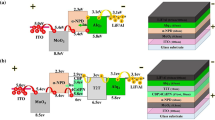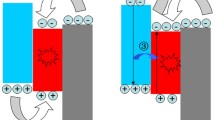Abstract
In this study, we report the luminescence quenching by radical cations of aromatic diamines used as a hole transport layer (HTL) in organic electroluminescent (EL) devices. The EL characteristics of green organic EL devices with an electron transport layer (ETL) as an emitter i.e. ITO/TPD HTL/Alq3 ETL/Al is studied. Here, ITO, TPD, and Alq3 are abbreviations for indium-tin-oxide, N,N’-diphenyl-N,N’-bis(3-methylphenyl)-1,1’-biphenyl-4,4’-diamine, and tris (8-hydroxyquinoline) aluminum, respectively. UV-visible absorption and electrochemical data indicate the formation of radical cations in thin film and solution of TPD after chemical oxidation. We find that the EL luminance increases less than linearly with an increase in current for the EL devices studied in this study. The luminance loss in the devices is attributed to quenching of singlet excited states by large excess radical cations of TPD are accumulated in the emission zone due to large overlap between a flourescence spectrum of Alq3 and an absorption spectrum of radical cations of TPD.
Similar content being viewed by others
References
M. Pope, H. P. Kallmann, and P. Magnante, J. Chem. Phys. 38, 2042 (1963).
W. Helfrich and W. G. Schneider, Phys. Rev. Lett. 14, 229 (1965).
W. Helfrich and W. G. Schneider, J. Chem. Phys. 44, 2902 (1966).
W. Tang and S. A. VanSlyke, Appl. Phys. Lett. 51, 913 (1987).
M. Fujihira and C. Ganzorig, “Molecular Control of Electron and Hole Injection at Electrodes and at Organic Layer Interfaces in Organic Electroluminescent Devices” in Conjugated Polymer and Molecular Interfaces, edited by A. Kahn, J. J. Pireaux, W. R. Salaneck and K. Seki, (Marcel Dekker, New York, 2002) pp. 817–858.
C. Ganzorig and M. Fujihira, Appl. Phys. Lett. 81, 3137 (2002).
C. Ganzorig and M. Fujihira, Mat. Res. Soc. Symp. Proc. 771, 105 (2003).
M. Fujihira and C. Ganzorig, “Study of Hole Injection in Hole-Only Single-Layer Devices,” in Multifunctional Conducting Molecular Materials, edited by G. Saito, F. Wudl, R. C. Haddon, K. Tanigaki, T. Enoki, H. E. Katz, and M. Maesato (RSC, Royal Society of Chemistry, Cambridge, 2007) pp. 253–269.
C. Ganzorig and M. Fujihira, Appl. Phys. Lett. 77, 4211 (2000).
C. Ganzorig, K. Suga, and M. Fujihira, Chem. Lett. 29, 1032 (2000).
Author information
Authors and Affiliations
Rights and permissions
About this article
Cite this article
Battulga, M., Bolormaa, G., Naranbileg, B. et al. Singlet Exciton Quenching by Radical Cations of Aromatic Diamines as an Electron Donor in Organic Electroluminescent Devices. MRS Online Proceedings Library 1286, 316 (2010). https://doi.org/10.1557/opl.2011.7
Published:
DOI: https://doi.org/10.1557/opl.2011.7




